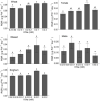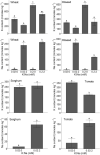Reducing potassium deficiency by using sodium fertilisation
- PMID: 37676370
- PMCID: PMC10441835
- DOI: 10.1007/s44154-022-00070-1
Reducing potassium deficiency by using sodium fertilisation
Abstract
Potassium (K) is the most abundant cation in the vast majority of plants. It is required in large quantities which, in an agronomic context, typically necessitates application of K in the form of potash or other K fertilisers. Recently, the price of K fertiliser has risen dramatically, a situation that is paralleled by increasing K deficiency of soils around the globe. A potential solution to this problem is to reduce crop K fertiliser dependency by replacing it with sodium (Na) fertiliser which carries a much smaller price tag. In this paper we discuss the physiological roles of K and Na and the implications of Na fertilisation for crop cultivation and soil management. By using greenhouse growth assays we show distinct growth promotion after Na fertilisation in wheat, tomato, oilseed and sorghum. Our results also show that up to 60% of tissue K can be substituted by Na without growth penalty. Based on these data, simple economic models suggest that (part) replacement of K fertiliser with Na fertiliser leads to considerable savings.
Keywords: Deficiency; Fertiliser; Nutrient; Potassium; Salinity; Sodium.
© 2022. The Author(s).
Conflict of interest statement
The authors have no financial or non-financial interests that are directly or indirectly related to the work submitted for publication.
Figures



Similar articles
-
Biochar compound fertilisers increase plant potassium uptake 2 years after application without additional organic fertiliser.Environ Sci Pollut Res Int. 2022 Jan;29(5):7170-7184. doi: 10.1007/s11356-021-16236-9. Epub 2021 Sep 1. Environ Sci Pollut Res Int. 2022. PMID: 34472026
-
The Influence of Mineral NPK Fertiliser Rates on Potassium Dynamics in Soil: Data from a Long-Term Agricultural Plant Fertilisation Experiment.Plants (Basel). 2023 Oct 27;12(21):3700. doi: 10.3390/plants12213700. Plants (Basel). 2023. PMID: 37960056 Free PMC article.
-
Conversion from mineral fertilisation to MSW compost use: Nitrogen fertiliser value in continuous maize and test on crop rotation.Sci Total Environ. 2020 Feb 25;705:135308. doi: 10.1016/j.scitotenv.2019.135308. Epub 2019 Nov 29. Sci Total Environ. 2020. PMID: 31841924
-
Changes in the efficiency of fertiliser use in China.J Sci Food Agric. 2012 Mar 30;92(5):1006-9. doi: 10.1002/jsfa.4700. Epub 2012 Jan 10. J Sci Food Agric. 2012. PMID: 22234968 Review.
-
Potassium: A track to develop salinity tolerant plants.Plant Physiol Biochem. 2021 Oct;167:1011-1023. doi: 10.1016/j.plaphy.2021.09.031. Epub 2021 Sep 25. Plant Physiol Biochem. 2021. PMID: 34598021 Review.
Cited by
-
Plasticity of wheat seedling responses to K+ deficiency highlighted by integrated phenotyping of roots and root hairs over the whole root system.Stress Biol. 2023 Apr 6;3(1):5. doi: 10.1007/s44154-023-00083-4. Stress Biol. 2023. PMID: 37676444 Free PMC article.
-
Impact of Nutrient Stress on Plant Disease Resistance.Int J Mol Sci. 2025 Feb 19;26(4):1780. doi: 10.3390/ijms26041780. Int J Mol Sci. 2025. PMID: 40004243 Free PMC article. Review.
-
A K+-Efflux Antiporter is Vital for Tolerance to Salt Stress in Rice.Rice (N Y). 2025 Jun 21;18(1):57. doi: 10.1186/s12284-025-00815-2. Rice (N Y). 2025. PMID: 40542901 Free PMC article.
-
Organ-specific responses during acclimation of mycorrhizal and non-mycorrhizal tomato plants to a mild water stress reveal differential local and systemic hormonal and nutritional adjustments.Planta. 2023 Jun 27;258(2):32. doi: 10.1007/s00425-023-04192-2. Planta. 2023. PMID: 37368074 Free PMC article.
References
-
- Ahmad I, Maathuis FJM (2014) Cellular and tissue distribution of potassium; physiological relevance, mechanisms and regulation. J Plant Physiol 171:708–714. 10.1016/j.jplph.2013.10.016 - PubMed
-
- Alfaro MA, Jarvis SC, Gregory PJ (2004) Factors affecting potassium leaching in different soils. Soil Use Manag 20: 182–189, https://doi.org/10.1111/j.1475-2743.2004.tb00355.x
-
- Álvarez-Aragón R, Rodríguez-Navarro A (2017) Nitrate-dependent shoot sodium accumulation and osmotic functions of sodium in Arabidopsis under saline conditions. Plant J 91(2):208–219. 10.1111/tpj.13556 Epub 2017 Jun 6. PMID: 28370621 - PubMed
-
- Baffes J, Koh WC (2022) Worldbank Blogs: https://blogs.worldbank.org/opendata/fertilizer-prices-expected-remain-h...
-
- Benito B, Haro R, Amtmann A, Cuin TA, Dreyer (2014) The twins K+ and Na+ in plants. J Plant Physiol 171(9):723–731. 10.1016/j.jplph.2013.10.014. - PubMed
Publication types
LinkOut - more resources
Full Text Sources

